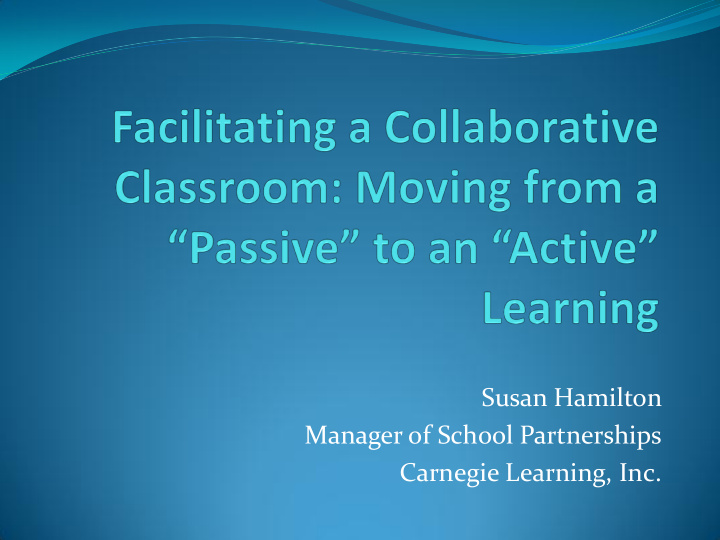



Susan Hamilton Manager of School Partnerships Carnegie Learning, Inc.
Session Objectives: Discuss ways to move your classroom from “passive” to “active”. Leave with ideas to take back to school & teachers.
Student-Centered?
What is a student-centered classroom? Use your familiarity with cooperative learning, either from a learner or teacher perspective: • Think of good experience you had… • Think of a not so good experience you had…
How Students Learn According to statistics from the National Literacy Trust, learners learn: 5% - by lecture 10% - by what they read S 20% - by what they hear H 30% - by demonstration I F 50% - by discussion T 75% - by doing practice 90% - by teaching one another 95% - by teaching and assessing one another Roy, Rotna. "Active learning." Mathematics Teaching Nov. 2008: 36 .
Why a student-centered classroom? Then, by allowing students to interact with and struggle with the mathematics using their ideas and their strategies – a student-centered approach – the mathematics they learn will be integrated with their ideas; it will make sense to them, be understood and be enjoyed. John Van de Walle
What does a student-centered classroom look like? Student work should be displayed. Desks or tables arranged to encourage student collaboration. Materials readily available. Word wall. Launch problem scenario to check for student understanding. Students engaged in solving math problems and communicating their understanding. Lesson closure and summary of primary mathematical objectives from the day.
How to make a classroom student-centered? Make the student more aware of what they are doing and why they are doing it. Make the student more active in acquiring knowledge and skills. Make students more interacting with each other . Develop student’s transferable skills.
Numeric Networking Making Connections Instructions: • Starting at one, and moving through the numbers as high as you can; each group aims to find that number of things/objects/experiences that they have in common. • Once I say ”Go”, you may start your numeric networking. • The person with the least number of years teaching will be the recorder for you group. • You will have 3 minutes to make as many numeric connections as you can.
Numeric Networking Debrief Possible Questions: • What was challenging about this activity? • What did you find easier with this activity? • What made me choose this activity? • What did you learn and how will you use that today?
Carousel Activities Round 1: Draw the basic Round 2 : Review previous work; function f(x) = x and label. create f’(x) by shifting every point horizontally to the left 6 units Round 5 : Review previous work and be prepared to Round 3 : Review previous share out to the class. work; create f’’(x) by reflecting the graph over the y-axis . Round 4 : Review previous work; create f’’’(x) by rotating the graph 90 degrees .
Placement Assign each member of the group a, b, c, d. Each person will work on their problem in the space SUM provided (all four people work on 1 paper) Place the sum of all problems in the center. All members raise their hands when finished.
Sharing Out How are students going to share out what knowledge they have gained? How do you know if the sharing is successful?
Good Questions… • help students make sense of the math. • are open-ended , whether in answer or approach. There may be multiple answers or multiple approaches. • empower students to unravel their misconceptions. • not only require the application of facts and procedures but encourage students to make connections and generalizations Schuster and Anderson, Good Questions for Math Teaching,
Scripting Good Questions… What questions will you ask when students… • Demonstrate misconceptions? • Ask you for help? • Struggle to get started? • Extend their thinking?
Self-Reflection When thinking about how you worked today; text me something you did well today and something you would like to do better next class.
Team-Reflection As a group, list 3 ways to increase involvement next class… As a group, what are 2 things we did well today… As a group, what is 1 thing we could do differently next class…
What Can We Do? “We can learn how to vary our strategies and engage students more fully in the learning process. We can learn to allow students to provide more of the mathematical conversation in the classroom than we provide. We can learn how to ask the questions that push students’ thinking toward higher levels, without overly scaffolding or spoon-feeding them everything they need to solve a problem .” Cathy Seeley, Past-President NCTM Faster Isn’t Smarter
INK YOUR THINKING j ot down your thoughts about the collaborative strategies… What did you learn today ? So What ? (relevancy, importance, usefulness) Now What? (how does this fit into your classroom)
Recommend
More recommend